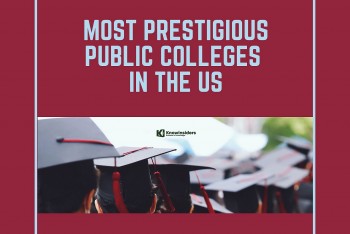How Many Universites/Colleges Are There in the U.S?
 |
| How Many Colleges Are in the U.S? |
The Number of Colleges in the United States: Key Facts
• The National Center for Education Statistics (NCES) says that there are 5,999 colleges and universities in the U.S. as of the 2019–20 school year. Sixty-six percent of those schools are actually postsecondary institutions that give degrees.
• A new report from NCES says that as of October 2024, there are 5,916 colleges in the United States.The number of colleges and universities has gone down by just over 13% in the last five years.
• A big part of the higher education system is made up of colleges and universities that give degrees. Out of those schools, more than 3,900 offer degrees after high school.
• Even though enrollment and numbers are going down, college is still an important part of education in the United States.
• Four-year schools are mostly made up of private, non-profit institutions.
Learn more: How Many Public/Private Schools Are There In The US?
How Many Universites/Colleges Are in the U.S as of 2024?
The most recent NCES report indicates that the number of colleges and universities in the United States is steadily decreasing, with a mere 5,916 institutions serving 15.9 million undergraduate and 3.1 million graduate students by the end of 2024. 3,928 of these postsecondary institutions also provide distance learners with the opportunity to pursue higher education through online degree programs, remote courses, and training, thereby enabling a greater number of individuals to access higher education.
The sheer number of options available can be overwhelming, as there are nearly 6,000 colleges and universities throughout the country. With an abundance of alternatives, you are certain to identify the appropriate institution that aligns with your educational and professional objectives, accommodates your financial constraints, and aligns with your learning style.
A substantial number of private nonprofit four-year schools, as well as the majority of degree-granting postsecondary institutions, provide a wide range of educational opportunities to the nearly 20 million students who enroll in their programs.
Types of Colleges in the U.S
People in the U.S. can go to public, private, nonprofit, for-profit, two-year, or four-year colleges.
The number of degree-granting colleges and universities in the US dropped from 7,021 in 2010-2011 to 5,916 by the 2020-2021 school year. These are made up of 2,270 private for-profit institutions, 1,892 public institutions, and 1,754 private nonprofit institutions.
You can use Title IV federal aid to help pay for these degree-granting schools' tuition and fees because they follow the rules. Each type of school serves a different group of people and has a different budget because each school gets and spends money in different ways based on its mission and goals. Because of this, each has programs that are tailored to its purpose and the needs of its students.
Public colleges and universities
Public colleges and universities are nonprofit institutions that primarily obtain their funding from the federal government. These institutions are typically the largest, provide a wide array of programs, and may be cost-effective.
Private colleges and universities
Federal grants, tuition, and donations fund nonprofit private schools. School funds are reinvested to improve education and student outcomes. They may offer fewer programs and be smaller and more expensive than public institutions.
Private investors, federal grants, and tuition fund for-profit schools. They operate like businesses because investors receive most of their profits. These schools are often scrutinized. Due to their deceptive student recruitment and profit-making, some are called "diploma mills".
 Top 10 Most Expensive Private Colleges in the U.S By Net Cost Top 10 Most Expensive Private Colleges in the U.S By Net Cost |
Number of Public vs. Private Colleges in the U.S.
There were 1,576 public colleges and universities and 2,160 private colleges and universities in the U.S. as of the 2020-21 school year.
Number of Nonprofit vs. For Profit Colleges in the U.S.
During the same time period, there were 3,154 nonprofit and 582 for-profit institutions of higher learning across the country.
As of the 2020-21 academic year, the United States had 2,520 four-year colleges and universities and 1,216 two-year institutions.
 Top 20 Most Prestigious Public Colleges In The US Top 20 Most Prestigious Public Colleges In The US |
What States Have the Most Colleges?
Pennsylvania, Texas, New York, and California are some of the states with the highest concentration of colleges and universities. Every state has more than 200 institutions; the only one with more than 300 is California. In California, New York, and Texas, three of these four states have more than a million college students enrolled. The University of California, California State University, and the University of Texas are the three biggest public university systems in the nation, and they are located in California and Texas.
During the 2020–2021 academic year, California boasted the highest number of higher education establishments in the United States with 384. With 137 campuses catering to about 2 million students, the California community college system stands as the biggest in the United States on its own. There are 150 public, 142 nonprofit, and 92 for-profit colleges and universities in the state, not counting the community college system.
115 community colleges make up the California Virtual Campus, which offers more than 10,000 online degree, certificate, and course programs. With 23 campuses spread across the state, Cal State Online serves over 481,000 students virtually. You can complete your degree entirely online or through a hybrid program that requires 50% of your coursework to be completed on campus.
What States Have the Fewest Colleges
Alaska, Delaware, and Wyoming are among the states with the fewest colleges and universities. Each state has fewer than 10 institutions and serves fewer than 61,000 students.
The Number of Colleges Offering Online Courses
There are 3,928 colleges and universities that offer some kind of distance education. As of Fall 2020, 422 of them are mainly offering online courses and programs. There are almost 19 million students at public, private, nonprofit, and for-profit colleges and universities that these schools serve.
1,586 public colleges and universities and 2,342 private colleges and universities offer degrees and courses online.
There are 3,224 for-profit schools and 704 nonprofit schools in the U.S. that let you take classes or get a degree online.
FAQs
How many colleges are there in the USA?
As of the 2020–21 academic year, there are 5,916 postsecondary Title IV institutions in the United States.
How many 4-year colleges are there in the US?
There are 2,637 four-year colleges in the United States as of the 2020–21 academic year.
What US College Has the Most Students?
Western Governors University (WGU) had the most students of any college in the U.S. in the fall of 2020, with 147,866 signed up.
Do all 50 states have colleges?
Yes, all 50 states, including the District of Columbia have postsecondary institutions.
Which State Is #1 in Higher Education?
With 384 colleges and universities spread out across the state, California boasts the most higher education institutions compared to any other state. This state had the highest enrollment of any in 2020, with nearly 2.6 million students attending classes on campus and online.
How Many Accredited Colleges Are in The U.S.?
The Council for Higher Education Accreditation says that in the U.S. there are more than 8,200 accredited colleges and universities with more than 44,000 programs.
In Conclusion
The selection of a school for college can influence your financial obligations, the programs available for enrollment, the mode of class delivery (online or on-campus), and the alignment of your peers' objectives with your own. You can select from numerous schools throughout the U.S. that are accessible, affordable, align with your needs, and influence your future.























